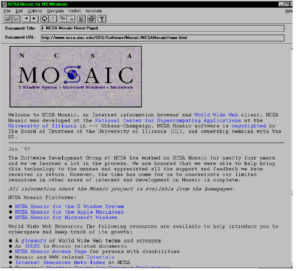Mondays with Mike: “Boom” goes the dynamite
January 28, 2019 • 7 Comments • Posted in Mike Knezovich, Mondays with Mike, Uncategorized
That’s what the web looked like in 1993. Click on the image for a great story in Wired about the excitement Mosaic created.
I just watched a couple episodes of a Nat Geo mini-series that looks back at those heady days of the dot.com boom. Overall I liked The Valley of the Boom more than I thought I would—generally, I think people who’ve had a front row seat for an event that is covered in the news or on the screen find fault in these things.
I certainly did, but more on the fault thing later. What the show captured well was the sense that at the time, it seemed like now all things were possible, all old assumptions and rules were out the window, that the sky was the limit—it bordered on a sort of rapture. Every staff member at every company woke up every day either thinking they would conquer the world, or go out of business by month’s end, and some days both.
Last year about this time I posted about the 25thanniversary of the Mosaic web browser. Mosaic was developed at the University of Illinois at Urbana Champaign’s National Center for Supercomputing Applications. The Mosaic browser made the World Wide Web—previously the realm of researchers, government agencies, and large government contractors—available to the rest of us. And the rest is history, as they say.
Charlatans were everywhere, and it was hard to pick them out from the crowd because even the good guys could seem delirious and sort of evangelical sometimes.
One of those good guys was my boss, Doug Colbeth—who’s still a friend, I’m proud to say. Doug turned Spyglass, a scientific software company fighting for survival in Champaign, Illinois, into an unlikely dot.com in the middle of DuPage County that went public in 1995 against all odds.
We really didn’t stand a chance against Netscape and other behemoths located in Silicon Valley, with their access to armies of experienced staff and oodles of capital. But somehow….
Doug knew early that the so-called “browser wars” were a blip. That the browser was a commodity, a valuable one, but in the same way that a screwdriver is valuable. And, that there was not a sustainable business to be built on browsers.
He was right. Spyglass licensed and commercialized Mosaic, then licensed its browser code to Microsoft, and that code turned into Internet Explorer. Which ended up absolutely destroying Netscape Navigator, and, eventually, Netscape. Meanwhile, Spyglass pursued what was to some a hare-brained strategy: That web technology and mini browsers would eventually be built into devices ranging from gas pumps to TVs to refrigerators refrigerators. Spyglass built a highly profitable business and was eventually sold to a TV technology company.
Anyway, I confess to some certain satisfaction during the scene in “Boom” in which the Netscape CEO announces the sale of Netscape to AOL. In essence, it was the end of Netscape. And I took some pride in the knowledge that our little company, a mouse that roared, won that browser war.
As for the show, it does what the mainstream press did in real time: For the sake of story, they focus on the high-profile rock stars. Marc Andreessen, the maladjusted tech wunderkind. Jim Clark, a Silicon Valley icon. And Jim Barksdale, the celebrity CEO.
We love boy-hero stories but advancements are always a collective thing, more nuanced, and more inspiring than the wunderkind stuff, if you ask me. It’s story of steady progress built on brilliance and work and stacked on the shoulders of forbears. This web thing goes back to the likes of Tim Berners-Lee at CERN
and Vint Cerf. And they built on the work of their predecessors and colleagues.
In any case, “Boom” is a worthwhile watch, well acted, and nicely peppered with interviews with the real players looking back on that insane era. And it was nuts!
Glad I had a front row seat.



